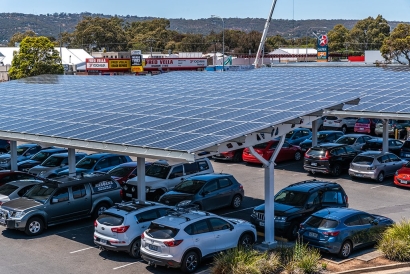Informational Report
Sustainability Across the City of New York
Oct 23, 2024
“The Environmental Protection Agency estimates that paved areas can boost the temperature in cities by as much as 22°F” (EPA.com, 2024). In New York City (NYC), many shopping centers, universities, and even some residential buildings across the five boroughs offer convenient commuter parking spots. These parking spots trap heat and radiate back into the air, making it hotter than it should be. Because fellow commuters can be overwhelmed by the heat of parking lots, building owners often provide more air conditioning than necessary to cool people at these centers. As temperatures rise, so does energy consumption. This is an issue, especially during the summer, because more energy creates more carbon emissions, so the climate gets warmer and warmer. Parking centers need to be more efficient; they’re in direct sunlight, and light traps heat, so how do we fix this issue? Solar panels can use sunlight to generate electricity and shade parking spots, preventing cars and concrete/asphalt from trapping heat. At CCNY, they’re remodeling their existing parking lot, installing solar panels to generate electricity, and providing shade. This should lower the building’s energy bill while preventing the asphalt from trapping and generating heat. NYC should offer incentives to businesses and building owners to build solar panels on existing parking lots, whether providing some funding or assisting in construction. The NYC Department of Energy and Buildings should provide the infrastructure or incentivize the demand for solar panels across the city to combat the incoming energy and climate crises.
Currently, many malls exist, especially in Queens, each with parking lots for shoppers. Given the popularity of malls and convenient parking lots in residential areas, many parking lots are about 300 square feet on average. Malls like Rosevelt Field and Green Acres have parking lots surrounding the many buildings’ perimeter, resulting in about 2,000 parking spaces or about 12 acres of land. Because parking lots are made of asphalt, a black pigmented surface, and are in direct sunlight, the average temperature can be 15°F higher than usual. A great way to deal with both of these issues simultaneously is solar panels. Depending on how many solar panels are used and the efficiency of said solar pane, The average solar panel has a power output rating of 250 to 400 watts (W) and generates around 1.5 kilowatt-hours (kWh) of energy per day” (MarketWatch.com, 2024), the energy production of such a solar farm will be monumental. Using ⅓ of the parking lot land, the Roosevelt Field Mall parking lot alone can produce just under One Megawatt of energy per hour. To put this into context, one megawatt of energy can power 1000 homes of average size! We could better use up our land to make energy rather than spending energy to maintain cooler temperatures. Funding from the federal and local governments should help incentivize business owners to build mini solar farms in our cities to help keep carbon emissions at a minimum while providing clean energy alternatives to fossil fuels.
Business owners might oppose investing money to build solar panels in their parking spaces because they might think it’s expensive or not worth their time. If we’re talking about the cost of building these solar energy systems, the federal government will cover some of the prices under some new Renewable Energy Act. The cost of creating such a massive farm is just under one million dollars; let’s say that with federal aid and the help of electrical companies, 40% of the cost is taken care of. It’ll take approximately two years to break even on such an investment. On top of that, business owners won’t have to worry about high electricity bills because, once again, solar panels create electricity to maintain their buildings. Any excess energy produced may be sold off as profit; solar panels are a creative investment because they have 20-25 years of lifespan. Alternatively, not everyday is a sunny day, there might be clouds, rain, or other meteorological conditions that may disrupt energy production. However, looking at this long-term investment, it helps increase property value. Solar energy is the way to go for land that isn’t efficiently used, rather than it serving one purpose, we can change the way these commercial and residential areas are powered.
Solar panels are the way to go for future energy production. They use otherwise inefficient land that costs a lot of money to maintain. We must change our energy dependency from fossil fuels to renewable sources. Dedicated parking spaces are acceptable to an extent, but their main unintended consequence is that they trap and radiate heat back into the air. Solar panels absorb the sun’s heat and turn it into usable energy to block the sun from hitting the ground.



